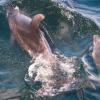The effect of seasonal and human pressure on macrobenthic fauna in the Caroni Swamp Ramsar Site, Trinidad and Tobago Research Paper
Human pressures have placed many tropical estuaries in developing countries under increased levels of stress. The Caroni Swamp Ramsar Site, the largest mangrove swamp along the west coast of Trinidad, has been subjected to high levels of anthropogenic impacts including hydrological alteration and pollution from land-based sources since the 1920’s. While most of these impacts have been well documented, limited information exists on the macrobenthic communities in the swamp. This study addresses the paucity of information. The macrobenthic fauna in the main waterways of Caroni Swamp was sampled at 12 locations using a Van Veen 0.025 m2 grab, once in the dry (April) and wet (August) season of 2015 with a total of 144 samples. The samples were sorted, counted and species were identified to the lowest possible taxonomic level. A total of 55 taxa were identified with polychaetes being the most abundant taxa. The ecological status of the macrobenthos was assessed using AZTI’s Marine Biotic Index (AMBI) and the multivariate-AMBI (M-AMBI). Physicochemical parameters were measured with a YSI multiparameter metre. Chemical analyses were also conducted on nitrates, nitrites, ammonia and reactive phosphates using standard methods. Overall, AMBI characterised the Caroni Swamp as “slightly disturbed” with a macrobenthic community of “poor” ecological status according to M-AMBI. Generally, the quality of the environment improves from the dry season to the wet season. However, seasonal variations in AMBI and M-AMBI were found to be site specific as some showed improvement in ecological status and macrozoobenthos quality while others showed degradation from the dry season to the wet season. The stations to the North of the swamp showed improvement from the dry season to the wet season while the opposite was observed in the more Southern stations. One notable characteristic of the swamp was the high levels of pollutants, particularly ammonia, recorded in one of its major waterways, the Caroni River. This is in contrast to the other waterways within the swamp which experience much lower levels of pollutant input from land-based sources. The assessment of the Caroni Swamp using AMBI and M-AMBI may be useful for informing management strategies to conserve the wetland and improve environmental quality. Rev. Biol. Trop. 66(3): 1101-1117. Epub 2018 September 01.
Area of interest: Trinidad & Tobago
Year: 2018




